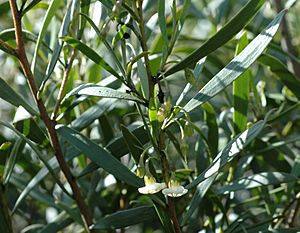Turkey bush facts for kids
Eremophila deserti is a type of shrub that grows only in Australia. It has many common names, like turkey bush, dogwood, poison bush, Ellangowan poison bush, pencil bush, and carrot bush. This plant is very common and can be found in all mainland Australian states, except for the Northern Territory. Some kinds of turkey bush can be harmful to farm animals if they eat them.
Quick facts for kids Turkey bush |
|
|---|---|
 |
|
| Eremophila deserti growing near Sunbury | |
| Scientific classification | |
| Genus: |
Eremophila (plant)
|
| Species: |
deserti
|
| Synonyms | |
|
|
Contents
What Does the Turkey Bush Look Like?
The turkey bush can grow in different ways. It might be a short, spreading bush about 0.5 m (2 ft) tall. Or, it can be a tall, upright shrub up to 4 m (10 ft) high. When the leaves and branches are young, they feel sticky and look shiny. This is because they have a natural sticky substance called resin.
The leaves grow one after another along the stems. They are usually 25–50 mm (1–2 in) long and 3–6 mm (0.1–0.2 in) wide. The leaves are thick, shaped like a line, and have a hooked end. They are also smooth, meaning they have no hairs.
Flowers and Fruits
The flowers of the turkey bush smell like honey. They grow alone or in small groups of up to three where the leaves join the stem. These flowers are on sticky, smooth stalks that are 7–12 mm (0.3–0.5 in) long. Each flower has five smooth, green, triangle-shaped parts called sepals. These are about 1–3 mm (0.04–0.1 in) long.
The five petals of the flower are joined together at the bottom to form a tube. This tube is 2–6 mm (0.08–0.2 in) long. The ends of the petals form lobes that are another 1.5–3 millimetres (0.06–0.1 in) long. The petals are usually white or cream-colored, sometimes with a little pink near the bottom. The petal lobes are similar in shape, but the bottom middle one has a small notch. The inside of the petal tube is mostly smooth.
Unlike most plants in its family, the turkey bush has five stamens, which are the parts that produce pollen. These stamens almost block the opening of the petal tube. The turkey bush can flower in most months of the year. After the flowers, the plant produces fruits. These fruits are soft and start as pale yellow. As they get older, they turn brownish-purple. They are oval or almost round and are 4–6.5 mm (0.2–0.3 in) long.
Where Does the Turkey Bush Grow?
The turkey bush is found across many parts of Australia. It grows widely in southeastern Queensland, often in areas with brigalow trees. You can also find it in New South Wales and Victoria, where it grows in Eucalyptus woodlands. In South Australia and Western Australia, it is common in mallee woodlands. In Western Australia, it is more spread out and mostly found south of 25°S latitude, especially along the Nullarbor Plain.
How Scientists Named the Turkey Bush
The turkey bush was first officially described in 1837 by a scientist named George Bentham. He used notes from another botanist, Allan Cunningham. The description was published in a book called Enumeratio plantarum quas in Novae Hollandiae ora austro-occidentali ad fluvium Cygnorum et in sinu Regis Georgii collegit Carolus Liber Baro de Hügel. Later, in 1986, Robert Chinnock changed its scientific name to Eremophila deserti. The second part of its name, deserti, comes from a Latin word meaning "a desert." This name was likely chosen because the plant was found in dry, desert-like areas.
Is the Turkey Bush Protected?
The Western Australian Government's Department of Parks and Wildlife says that Eremophila deserti is "not threatened." This means it is not currently in danger of disappearing.

